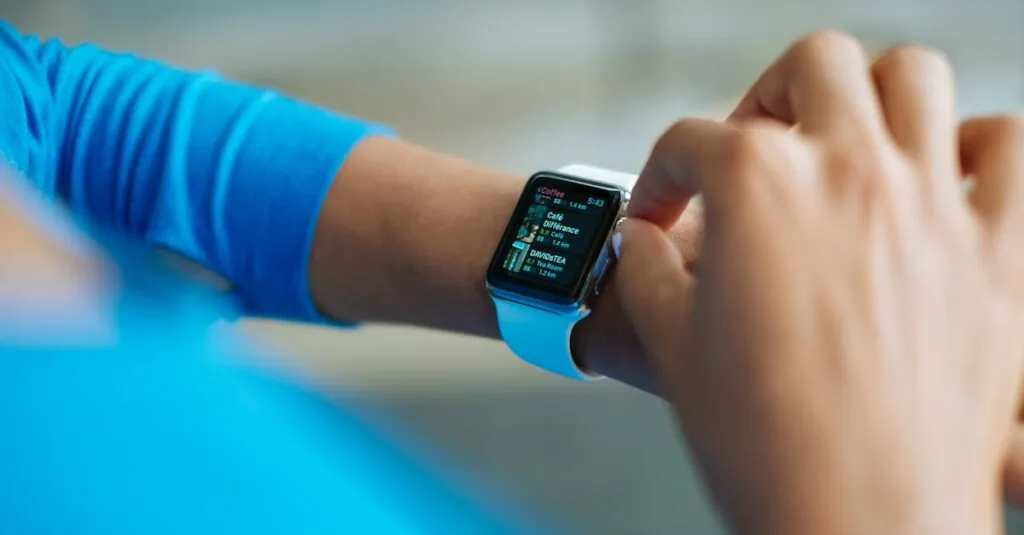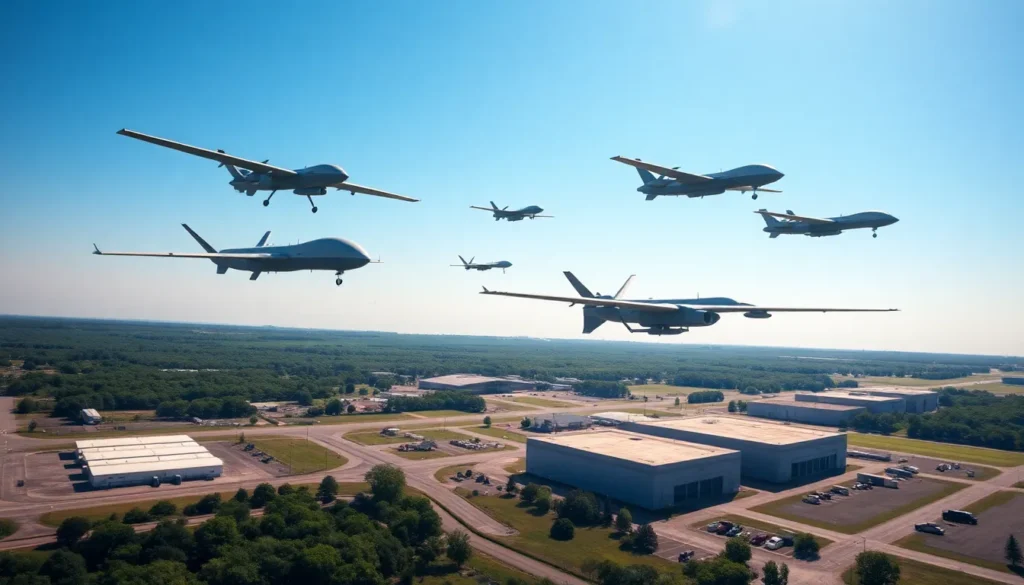Drones have taken to the skies like a kid on a sugar rush, but just how fast can these flying marvels zoom through the air? With speeds that can make your morning commute feel like a leisurely stroll, drones are redefining what it means to fly. Whether it’s delivering tacos or capturing breathtaking aerial shots, these high-tech gadgets are not just for fun—they’re becoming essential tools in various industries.
From racing drones that could give a cheetah a run for its money to commercial models that glide gracefully at impressive speeds, the world of drone flight is as diverse as it is exciting. Buckle up as we dive into the thrilling world of drone speeds, uncovering the facts and figures that make these flying machines the ultimate high-speed performers.
Table of Contents
ToggleOverview of Drone Speed Capabilities
Drones exhibit a wide range of speed capabilities, influenced by design and purpose. Racing drones often reach speeds of up to 100 mph (160 km/h), designed for agility and thrilling competition. Commercial drones, used for delivery or aerial surveying, generally operate between 15 mph and 50 mph (24 km/h to 80 km/h).
Some specialized models even achieve higher speeds, such as the Boeing Insitu RQ-21 Blackjack, capable of flying at approximately 70 mph (113 km/h). Military drones like the MQ-9 Reaper boast speeds around 300 mph (480 km/h), showcasing advanced technology and engineering.
Flight times and ranges also play a crucial role in drone performance. Racing drones prioritize speed and maneuverability over long flight times. Conversely, commercial and military drones balance speed with endurance to cover vast distances effectively.
Environmental factors significantly affect drone speeds. Wind resistance, temperature, and payload weight impact overall performance. Drones equipped with powerful motors perform better under adverse conditions, while lighter models may struggle in high winds.
Technological advancements continue to improve drone speeds and capabilities. Innovations in battery life, materials, and design enhance performance and efficiency. As the drone industry evolves, speeds are expected to increase, catering to the demands of various sectors.
Drones are reshaping industries, and understanding their speed capabilities reveals their potential. Exploring these specifications provides insights into how drones can meet diverse needs, ensuring they remain valuable tools in numerous fields.
Factors Affecting Drone Speed
Drone speed relies on several critical factors. Assessing these factors reveals how design, weight, motor power, and propulsion systems influence overall flight performance.
Weight and Design
Drones encapsulate various designs that directly impact their speed. Aerodynamic shapes reduce drag, enhancing flight efficiency. Lighter materials, such as carbon fiber, significantly decrease overall weight. Heavier drones struggle to accelerate quickly and maintain high speeds. For example, racing drones prioritize a lightweight frame to achieve speeds up to 100 mph. Consideration of size affects maneuverability as well, influencing the drone’s ability to navigate complex environments.
Motor Power and Propulsion
Motor power plays a vital role in determining a drone’s speed capacity. High-thrust motors provide the necessary lift and acceleration for quicker takeoff. Propulsion systems, including multiple rotors, distribute power effectively, enhancing flight stability. For instance, racing drones utilize high-performance brushless motors to reach top speeds. Commercial drones typically feature less powerful motors, balancing speed and energy efficiency. Efficiency in propulsion also impacts battery life, allowing drones to maintain speed over longer distances.
Types of Drones and Their Speed
Drones come in various types, each designed for specific applications and speeds. Understanding the differences aids in choosing the right drone for particular needs.
Consumer Drones
Consumer drones typically range in speed from 15 mph to 50 mph (24 km/h to 80 km/h). These devices serve recreational purposes, including photography and personal use. Popular models often feature user-friendly controls, making them accessible for beginners. Although speed isn’t their main focus, some high-end consumer drones can approach 60 mph (97 km/h). Features like GPS stability and obstacle sensors enhance their usability, allowing for smoother flights.
Racing Drones
Racing drones are built for speed, reaching up to 100 mph (160 km/h). They prioritize agility and quick maneuvering, appealing to competitive pilots. These lightweight machines often use powerful brushless motors and streamlined designs that enhance performance. Optimal aerodynamics contributes to their fast acceleration, giving racers an edge in competitions. Many racing events are organized globally, showcasing the impressive capabilities of these drones.
Commercial Drones
Commercial drones predominantly operate between 30 mph and 50 mph (48 km/h to 80 km/h). Their design emphasizes efficiency for tasks like delivery and surveying. While their speed may be lower than racing models, they excel in stability and endurance. Specialized models, such as those used for agricultural monitoring, maintain flight efficiency even at higher altitudes. Their capability to cover large areas quickly proves valuable for businesses across different industries.
Speed Comparisons Among Different Drone Models
Drones exhibit a remarkable range of speeds based on their design and purpose. Racing drones lead the pack, achieving impressive speeds up to 100 mph (160 km/h). These models feature high-performance components tailored for agility and speed.
Commercial drones typically fly at speeds between 15 mph and 50 mph (24 km/h to 80 km/h), balancing efficiency and operational range. Some advanced models may approach 60 mph (97 km/h), catering to more demanding applications.
Military drones like the MQ-9 Reaper stand out with speeds around 300 mph (480 km/h). Technical specifications make these drones ideal for surveillance missions, where speed and range are crucial. The Boeing Insitu RQ-21 Blackjack operates at approximately 70 mph (113 km/h), exemplifying the capabilities of specialized military drones.
Consumer drones, popular among hobbyists, generally operate between 15 mph to 50 mph (24 km/h to 80 km/h). Users often select these models for photography or recreational flying, with some high-end versions offering increased speed and performance.
Each drone category serves distinct needs, with speed playing a pivotal role in functionality. Motor power and aerodynamic design influence these speeds tremendously. Heavier drones typically face limitations that lighter materials, such as carbon fiber, can mitigate, leading to enhanced flight performance.
Understanding the specified speeds of various drone models aids users in choosing the right equipment for their specific purposes. Drones are an essential tool across industries thanks to their diverse applications, marrying speed and functionality effectively.
Drones are revolutionizing how industries operate with their impressive speed capabilities. From racing models that zip through the air at over 100 mph to military drones designed for high-speed surveillance, the variety is astounding. Each type of drone serves a unique purpose, showcasing the balance between speed and functionality.
As technology continues to advance, drone speeds are likely to increase, further enhancing their applications in fields like delivery, photography, and surveillance. Understanding the nuances of drone speeds helps users make informed decisions when selecting the right model for their needs. The future of drone technology promises even more exciting developments on the horizon.





